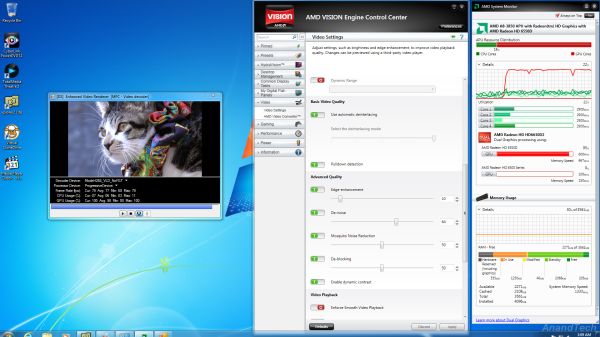AMD A8-3850 : An HTPC Perspective
by Ganesh T S on June 30, 2011 6:20 AM ESTDXVA Checker indicates the various capabilities of the AMD6550D, as exposed by the drivers.
The only puzzling aspect is the missing ModeH264MVC_VLD_Avivo entry which is present in the AMD 6xxx cards with UVD3. Instead, we have ModeH264_VLD_Multiview_Avido, which means that the Blu-ray players will have to interface with this new entry. AMD let us know that the 6550D doesn't have full hardware acceleration for 3D Blu-Rays. Some sort of extra assistance from the host CPU will be needed.
Our grouse with the low end AMD GPUs like the 6450 and 5450 was the fact that they were not certified for 1080p60 H.264 playback. Instead, they confined themselves to Blu-ray specs. With the advent of camcorders capable of 1080p60 recording, we believe this restriction should not be in place. What about the AMD 6550D?
We fired up DXVA Checker, and tried to benchmark a 1080p60 clip from a camcorder.
With all post processing steps enabled, I was pleased to find that the clip benchmarked at 77 fps, well beyond the 60 fps necessary to avoid frame drops.
With full hope, I tried playing back the clip in MPC-HC. As it turned out, approximately half the frames were dropped with ESVP on. Manually disabling all post processing options enabled us to play back the clip without frame drops (except for the initial startup trouble).
The discrepancy between DXVA Checker and MPC-HC was a surprise. They tallied without issues when we were benchmarking the discrete GPUs earlier this month. Either DXVA Checker or MPC-HC has problems with the AMD 3550D, and hence, we decided not to carry out the FPS benchmark for various codecs.
According to AMD, Blu-ray content shouldn't have any such issues. We took a 1080i60 clip from a Blu-ray (M2TS file) and tried playing it back in PowerDVD. Unfortunately, it looks like nothing other than Vector Adaptive (VA) deinterlacing is available, as shown in the gallery below.
In our opinion, it is not good for mainstream integrated GPUs to skimp on video post processing for Blu-ray videos itself.
All in all, even without running the DXVA benchmark, we have encountered a host of issues in playing back files at their native frame rate. Once the drivers get mature and the discrepancy between MPC-HC and DXVA Checker get resolved, we will probably revisit this. But, we wouldn't be surprised if AMD puts up its hands and says that the unit's functionality and performance are as per expectations.

















104 Comments
View All Comments
Galcobar - Friday, July 1, 2011 - link
Well, if Anandtech is so deeply in Intel's pocket, Intel might want their money back if the corporation were to read all the accusations of bias against Intel SSDs when Anandtech reviews an OCZ drive and concludes it's faster if less reliable.Well, as my journalism profs said, if everyone's angry at you, you're doing your job.
Musafir_86 - Friday, July 1, 2011 - link
Hi Ganesh,-Thanks for the article. As per your reply to me in the preceding article (by Anand), besides video quality, where are the comparison for gaming? Or am I wrong to expect image quality (IQ) comparison for 3D games here?
Thanks again.
ganeshts - Friday, July 1, 2011 - link
I misunderstood your original request for IQ testing. I thought it was for video playback.As for 3D games, I am not the right person since I don't play any games at all (except for running benchmarks). Let me ping a few people in our team and see if we can get that done and posted in a follow-up.
Musafir_86 - Friday, July 1, 2011 - link
-Okay, I will be waiting for it then. :DRegards.
jabber - Saturday, July 2, 2011 - link
A tip re. integrated graphics. All the PCs and laptops I get in with such setups all have The Sims installed.Can we have a Sims benchmark. Just saying as it would actually be a benchmark relevant to folks that actually use such machines.
I dont need to know it will only do 6fps with Crysis. I kinda know that.
mindbomb - Saturday, July 2, 2011 - link
i think the bug you are experiencing is related to the evr cp renderer. If you use an updated build, this should go away.ganeshts - Saturday, July 2, 2011 - link
Yes, I did find that on the MPC-HC IRC channel. But, the difference between BD-ISO and M2TS using TMT itself remains unexplained. The driver does lots of 'invisible' post processing when using EVR, so there is no reason why AMD didn't do that in this case.puretech - Saturday, July 2, 2011 - link
I truly hope that software developers takes the Fusion platform at this CPU performance level seriously. For many years now higher performance CPUs has not been needed by 99.5% of the consumers. It's not even possible anymore to to get the kids of today to understand what actually was possible to do already with a 486 based system 20 years ago, and the major problems even back then were slow disk I/O and poor graphics performance, not the CPU itself. Since then software development has only been for the highest CPU performance leading to sloppy programming and non-existent optimization, forcing people to upgrade the hardware to stay on "contemporary" operating systems. This review says more about the operating system and the application developers than the Fusion platform.ganeshts - Saturday, July 2, 2011 - link
I think the problem is more with the drivers rather than the Fusion GPU itself. But, that said, the drivers are themselves a part of the Fusion platform.Dobs - Saturday, July 9, 2011 - link
Since every other site is finding these hum with more memory & bandwidth, please retest with 8GB of 1866 Ram.And can the default GFX memory of 512 MB be increased to 1024 or 2048? What happens to the benchmarks then?
Thanks
Dobs